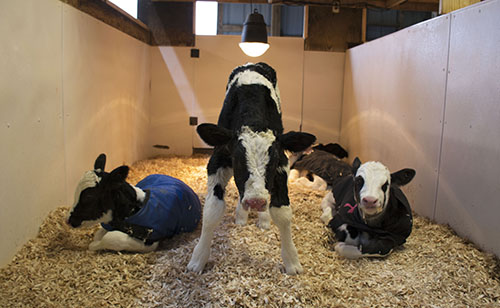
There's definitely a chill in the air, and for those of us in Northern climates, that chill is not going away any time soon.
Falling temperatures add to the challenges newborn calves face. With wet hair and just 2 to 4 percent body fat, these young animals are susceptible to frostbite, illness and even death when temperatures drop below freezing.
Some of these risks can be minimized if calves are dried quickly and thoroughly shortly after birth. This process can be sped up by placing calves in a warm environment. Commercially made warming boxes are available for farms to purchase, while other dairies have designed their own warming rooms or boxes.
If you're looking to add a warming box to your calf care routine, consider these recommendations from Michigan State University Extension Educator Faith Cullens to be sure you are creating a warm yet safe environment:
Cleanliness and sanitation: A warming box needs to be cleaned and sanitized frequently. Without proper cleaning and sanitation, the area can soon become a contaminated environment, creating a disease risk to calves.
Consider how walls and floors will be cleaned if there is a steady flow of calves. Cullens notes that two warming rooms or boxes may be needed so that one location can be cleaned out and dried while the other one is in use.
Ventilation: A small, enclosed space can be an air quality nightmare if not properly ventilated. In addition, Cullens says that without adequate ventilation, calves will not dry properly.
Sizing: The size of a warming box depends on the number of calves it will house and how long they will stay. There needs to be enough space for all calves to lie down comfortably. Calves can stay in a warming box for just a few hours or up to a few days, but if a warming box or room holds multiple calves, Cullens suggests they are moved out shortly after they are dry to avoid cross-contamination.
Heat source: A heat lamp can be a good heat source, but it carries a fire risk and doesn't move air around. Space heaters can work if the space is small, but a radiant heater with a fan probably works best and dries calves the fastest.
Bedding: If there are no drains on the floor, an absorbent bedding is needed. For floors with drainage, rubber mats are a nice option that can be easily cleaned.
Remember, the purpose of a warming box or room is to dry calves quickly and save them from some of winter's challenges. Be sure to make this space a clean and safe environment to help give calves the very best start, no matter what the thermometer outside says.

The author is an associate editor and covers animal health, dairy housing and equipment, and nutrient management. She grew up on a dairy farm near Plymouth, Wis., and previously served as a University of Wisconsin agricultural extension agent. She received a master's degree from North Carolina State University and a bachelor's from University of Wisconsin-Madison.








